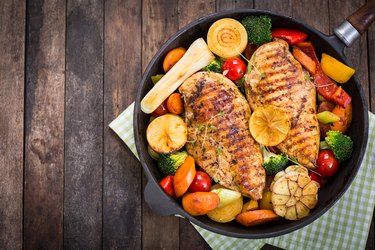
There appears to be no shortage of intermittent fasting methods. There's the OMAD diet, 16:8, 5:2, alternate-day fasting, eat-stop-eat and so on. The Warrior Diet is another type of intermittent fasting that claims to follow the eating patterns of ancient warriors.
The diet's founder claims it has many benefits, including easy weight loss. We'll break it all down here so you can decide if it's the right approach for you.
Video of the Day
Video of the Day
What Is the Warrior Diet?
This Warrior Diet was created in the early 2000s by Ori Hofmekler, who was a member of the Israeli Special Forces. He wrote the book The Warrior Diet based on his experiences, observations and interpretation of historical data dating back to the Ancient Greeks and Romans.
In the book, he describes this eating pattern as more of a lifestyle than a diet, with the goal being to improve the way people eat, feel, perform and look by triggering their survival instincts.
Hofmekler says that humans are not meant to eat three meals a day and that they function more efficiently when eating in the manner of ancient warriors: consuming very few calories during the day followed by a big feast each night. In this plan, there is a 20-hour "under-eating" period (think: 10 to 15 percent of your daily calories) and a four-hour window of "overeating" during which you can eat one large meal.
In his book, Hofmekler states that obesity, diabetes and other common diseases in today's society stem from eating too many meals during the day. He also claims that the human body works better when people eat sparingly during the day.
TL;DR
The Warrior Diet is a type of intermittent fasting similar to the OMAD (one-meal-a-day) diet. It calls for 20 hours of under-eating followed by four hours of overeating. The diet has three weeklong phases that each have different rules around the foods you can and cannot eat. While it may help you lose weight, it's not a healthy eating pattern, so you're better off trying a version of intermittent fasting that has research-backed benefits.
What Can You Eat on the Warrior Diet?
The Warrior Diet is broken up into three weeklong phases:
- Phase 1: Detox
- Phase 2: Higher fat
- Phase 3: Carb cycling
Foods to Eat During Phase 1
During your 20-hour fasting window, you can only eat and drink the following:
- Beverages: Water, coffee and tea (no sugar, small amount of milk), vegetable juice (carrot, parsley, celery)
- Raw fruits: Peeled apples, banana, kiwi, berries, grapefruit, oranges, papaya, mango, peach, pineapple, melon (grapes and watermelon are allowed only after a high-protein dinner)
- Vegetables: Tomatoes, peppers, onions, cucumber, mushrooms, sprouts, zucchini, carrots, cabbage, broccoli, cauliflower, Brussels sprouts, spinach, okra, spaghetti squash
- Plain yogurt
- Eggs
- Clear soup broth
- Salad: Mixed greens and vegetables from the list above with olive oil and vinegar used sparingly
During the four-hour feeding window, you are allowed the following for your main meal:
- Salad: See above, with olive oil and vinegar
- Steamed vegetables: From list above
- Beans and legumes: Lentils, mung beans, black beans, kidney beans, garbanzo beans, edamame
- Grains: Wild rice, brown rice, barley, quinoa (no wheat products)
Foods to Eat During Phase 2
Like the first phase of this diet, the second phase lasts one week and allows the same foods. During your four-hour overeating phase, though, you are allowed the following:
- Salad: As described in Phase 1
- Steamed vegetables: As in Phase 1
- Four to 6 ounces of protein: Chicken, fish, turkey, lean beef, eggs, plain yogurt, kefir, cottage cheese, ricotta cheese, feta cheese, goat cheese or Parmesan cheese
- One handful of nuts: Almonds, pecans, walnuts or pistachios
- Avoid any grains or starches in this phase
Foods to Eat During Phase 3
This weeklong phase alternates between high-protein days and high-carbohydrate days.
On high-carb days, your under-eating schedule will remain the same as above. For your main meal, you can eat the same foods as during Phase 2. The difference is that you are only allowed one main carbohydrate, such as:
- Corn
- Sweet potatoes
- Butternut squash
- Pumpkin
- Peas
- Potatoes
- Barley
- Rice
- Oats
- Quinoa
- Pasta
- Bread
On high-protein days, your under-eating schedule remains the same. During the four-hour eating window, you can eat a salad with oil and vinegar, followed by 4 to 6 ounces of protein (see Phase 2) and vegetables. No carbohydrates are allowed on these days.
Once Phase 3 is over, you are encouraged to repeat the process starting with Phase 1.
Foods to Avoid on the Warrior Diet
The types of food you're allowed to eat depends on the phase you are in, but you should avoid these foods and ingredients across the board:
- Highly-processed foods
- Fried foods
- Artificial sweeteners
- Chemical additives
- Foods containing hormones
- Beer and other alcoholic beverages (except for one glass of wine at dinner)

Can You Lose Weight on the Warrior Diet?
Yes, it's very likely that you will lose weight on the Warrior Diet. All types of fasting result in shorter periods of eating, which in turn typically leads to fewer calories consumed overall. Some research supports other potential weight-loss benefits of fasting, too, such as changes in gut bacteria and circadian rhythms.
For example, an April 2015 study published in the Journal of the Academy of Nutrition and Dietetics looked at different types of intermittent fasting and how they affect human health. Ramadan fasting is a type of religious fasting during which practitioners of Islam fast from dawn to sunset, in a manner that closely mimics the Warrior Diet.
In clinical trials, subjects who fasted in this way experienced marked reductions in body weight, cholesterol levels and inflammatory markers. As the researchers note, almost every type of intermittent fasting plan tested resulted in some weight loss.
Ready to Lose Weight?
Set yourself up for success with LIVESTRONG.com's Weight-Loss Kickstart.
Warrior Diet vs. the OMAD Diet
The Warrior Diet and the OMAD (one-meal-a-day) diet are very similar, but there are a few nuanced differences. They are similar in that they both promote eating one significant meal per day. Additionally, the founders of both diets appear to have no formal medical or nutrition training.
However, the OMAD diet doesn't have a set time of day that you should eat, while the Warrior Diet recommends eating your main meal at night. Also, the OMAD diet allows you to eat whatever you want for your one meal (yes, pizza and ice cream and burgers with fries are totally allowed), while the Warrior Diet has guidelines focused on whole, minimally processed foods.
Pros and Cons of the Warrior Diet
The Pros
There is one pro of the Warrior Diet from a nutrition standpoint: It encourages eating whole, minimally processed foods like vegetables, fruits, grains, lean proteins and beans/legumes. But this is about where the positive attributes end.
The Cons
1. The science is sparse: The diet was created by a person who has an interest in nutrition but no formal or accredited training. It's based on his experiences and observations, not research or medical literature. There are no published studies on the Warrior Diet assessing its safety or efficacy.
2. It could promote disordered eating: Fixating on very specific meal plans, foods you can and cannot eat, limited feeding windows and long periods of fasting can be problematic for some with a history of disordered eating. The Warrior Diet doesn't promote binging, but it can be hard to control your eating when you've gone 20 hours with limited eating and drinking. (Just think about how ravenous you get on the days you let too many hours lapse between lunch and dinner.)
3. It's not for everyone: If you're pregnant or breastfeeding, have a history of disordered eating, have a chronic illness, have blood sugar control issues or are an athlete, you'll want to steer clear of this diet. Even if you don't fall into any of those categories, you should consult with a dietitian before starting any new diet plan.
4. You'll be hard-pressed to meet your nutritional needs: We have a hard enough time as it is getting all of the nutrients we need. Most Americans come up short on fiber, potassium, choline, magnesium, calcium and vitamins A, D, E and C, according to the 2015-2020 Dietary Guidelines for Americans. Limiting the "eating window of opportunity" to just four hours makes it even more difficult, if not impossible to meet all of your nutritional needs.
So, Should You Try It?
Like the OMAD diet and other overly restrictive, under-researched diets, we give this one a hard pass. If you’re interested in intermittent fasting for weight loss or its other potential health benefits, consider trying the 16:8 method, which has a growing body of research to support its benefits and takes a more sustainable approach.
- Journal of the Academy of Nutrition and Dietetics: "Intermittent Fasting and Human Metabolic Health"
- Ori Hofmekler
- The Warrior Diet Fat Loss Program: "A Nutritional Guide to Maximize Fat Loss and Eliminate Stubborn Fat"
- 2015-2020 Dietary Guidelines for Americans: "Underconsumed Nutrients and Nutrients of Public Health Concern"